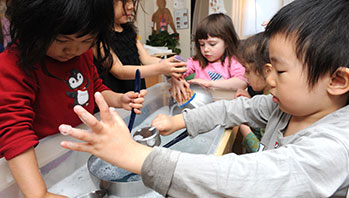- chart paper
- marker (or notebook)
- paper towels
- plastic pipettes or eyedroppers
- small containers of water
- wax paper
- drop
MA Standards:
Language/L.PK.MA.6: Use words and phrases acquired through conversations, listening to books read aloud, activities, and play.
Mathematics/Counting and Cardinality/PK.CC.MA.4: Count many kinds of concrete objects and actions up to ten, using one-to-one correspondence, and accurately count as many as seven things in a scattered configuration.
MA Draft STE Standards:
Earth and Space Sciences/Earth’s Systems/ESS2.A: Observe, investigate, and classify the non-living materials, natural and human made, in their environment.
Head Start Outcomes:
Logic and Reasoning/Reasoning and Problem Solving: Classifies, compares, and contrasts objects, events, and experiences.
Science Knowledge/Scientific Skills and Method: Uses senses and tools, including technology, to gather information, investigate materials, and observe processes and relationships.
Science Knowledge/Scientific Skills and Method: Collects, describes, and records information through discussions, drawings, maps, and charts.
Science Knowledge/Conceptual Knowledge of Natural and Physical Worlds: Observes, describes, and discusses properties of materials and transformation of substances.
PreK Learning Guidelines:
English Language Arts/Language 2: Participate actively in discussions, listen to the ideas of others, and ask and answer relevant questions.
Mathematics/Number Sense 2: Connect many kinds/quantities of concrete objects and actions to numbers.
Science and Technology/Inquiry Skills 3: Identify and use simple tools appropriately to extend observations.
Science and Technology/Inquiry Skills 4: Record observations and share ideas through simple forms of representation such as drawings.
Science and Technology/Physical Sciences 19: Explore, describe, and compare the properties of liquids and solids found in children's daily environment.
Explore Together (indoors): Introduce Water Drops

© Commonwealth of Massachusetts, Department of Early Education and Care (Jennifer Waddell photographer). All rights reserved.
STEM Key Concepts: Water in small amounts forms drops; Water drops stick together
ELA Focus Skills: Listening and Speaking, Vocabulary
Educator Prep: Set up a water drop table. Make several stations, each with a small container of water, a square of wax paper, and an eyedropper.
Safety Tips:
- Be sure to clean and disinfect the water table and the plastic containers daily and fill the table with fresh water each day.
- Be sure to have plenty of towels and/or a mop handy for clean-up of spills.
Gather children at the water drop table. Have children demonstrate using the eyedropper so you can be sure they are comfortable with the tool. If children are not clear on how to use the eyedropper, go through the steps with them. Say,
- First, squeeze the top.
- Hold it, hold it, hold it while you stick the eyedropper in the water.
- Now slowly let go and the eyedropper will suck the water up.
- Gently lift the full eyedropper up and then squeeze and squirt it!
Demonstrate once for children as you slowly squeeze drops out one at a time. Invite children to count the drops with you as you squeeze the water out, drop by drop, onto the wax paper. Say, One drop, two drops, etc.
Then distribute small containers of water and allow children to explore squirting or dripping water back into the containers. Encourage them to count one another’s drops as they gently squeeze the water out of the eyedropper. As children explore, circulate, listen, and engage them with questions such as,
- Do all the drops come out of the eyedropper the same size?
- Do all the drops come out of the eyedropper in the same way or in different ways?
- How do the water drops change?
Guide children to draw a picture to record their observations on chart paper or in their science notebooks.
Reflect and Share
Have children reflect on their observations and share any new ideas they learned about water drops. Encourage them to use their drawings as they share their ideas. Ask questions such as,
- What is the same about the way the water comes out of the eyedropper when you squeeze it forcefully and the way the water comes out when you squeeze gently? What is different?
- What is different about the way water squirts out of the eyedropper and the way water pours out of a bottle? You may want to have a cup handy to demonstrate. Ask children to describe in detail the differences in how the water flows from each container.
- How do the water drops change as you squeeze the top more gently? Why do you think this happens?
Educator Tip: Younger children especially may need help using the eyedroppers. Give one-on-one attention and help them practice doing this a few times to help them develop their fine motor skills.
